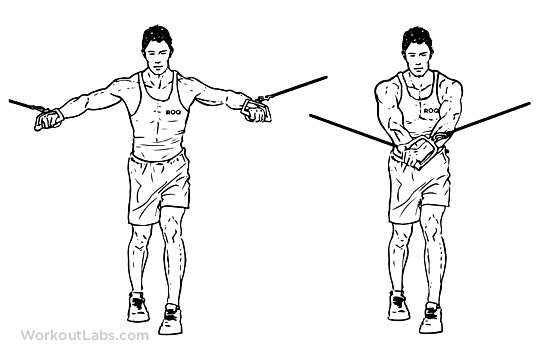By the healthiergang writer , student in Physiotherapy.
Cable Crossover
The cables are a very useful and versatile tool which allows the muscle to be subjected to continuous tension. The crossover is one of the many exercises that involve the use of cables.
This exercise in particular goes to train the pectoral muscle. Depending on the position in which the cables are placed, the focus can be shifted from the upper pectoral bundles, to the pectoralis major and also to the abdominal portion of the pectoral.
How is it done?
The movement of the crossover resumes the movement of the crosses with dumbbells. No wonder this similarity as both movements involve an adduction of the arm and thus recruit the pectoral muscle.
The advantage of the cable crossover compared to crosses with handlebars is that it does not subject the shoulder to very high stress. The shoulder adduction movement in fact significantly stresses this joint.
In crosses with dumbbells, for example in the position of maximum muscle extension, when the arms are parallel to the ground, the shoulder is placed in a position of great vulnerability.
This position also coincides with the point of greatest difficulty in the exercise. Considering the line of force exerted by the load, this is maximum when the angle it forms with the arm is 90 degrees. For these reasons, dumbbell crosses are an exercise to be avoided.
Performing the exercise in its complete ROM, the shoulder is at the point of greatest disadvantage at the point where it is most vulnerable. Crossover to cables is a safer alternative.

During the adduction movement the lines of force form a right angle just before the final portion of the movement or a little earlier depending on how you position yourself. If you keep your body in line with the cables at the beginning the tension is zero and then reaches its maximum in the first half of the movement.
If you take a step forward at the beginning of the movement there is already tension and the maximum is a little when the movement has just started. In general, the second position is the most profitable because it allows you to keep the muscle under constant tension.
A second advantage of the cable crossover is that of allow you to expand the range of motion and to adduce the arm beyond the medial sagittal plane (the one that divides the body into two halves).
An adduction of the arm beyond this plane also recruits the innermost muscle fibers of the pectoral muscle. This does not mean that there is a distinct "internal pectoral" muscle., rather it is meant that the pectoral is a fan-shaped muscle formed by many fibers that run in an almost horizontal line. depending on the degree of adduction of the arm, fibers are more involved than others.
A final trick to keep in mind when performing this exercise is to maintain a slight degree of flexion at the elbow. This allows you not to stress the joint too much. This degree of flexion must be kept constant throughout the movement if the pectoral is to be isolated, otherwise other muscles are involved.
Cable Placement And Variants
As mentioned above the positioning of the cables allows you to train the different bundles of the pectoral. If the cables are positioned high, the adduction movement will be directed downwards.
This mainly recruits the bundles of the pectoralis major and the abdominal portion. If the cables are placed at shoulder level the pectoralis major will be the major contributor to the movement. If the cables are positioned low and the movement is directed upwards, the clavicular bundle will be most involved together with the pectoralis major.
The variant that most respects the dynamics of movement of the shoulder is the first, from top to bottom. A good idea may be to crossover one arm at a time. This allows you to focus more on the contraction and also forces an activation of the abdominal muscles. One-sided tension tends to cause the trunk to rotate.
If this is maintained in a neutral position, therefore without rotation, it is necessary to work by the muscles that prevent a rotation of the torso: the oblique abdominals.
Set & Reps
This exercise is a movement of isolation. The repetitions must therefore be kept at 10-12 and the number of sets limited to 3-4.


























